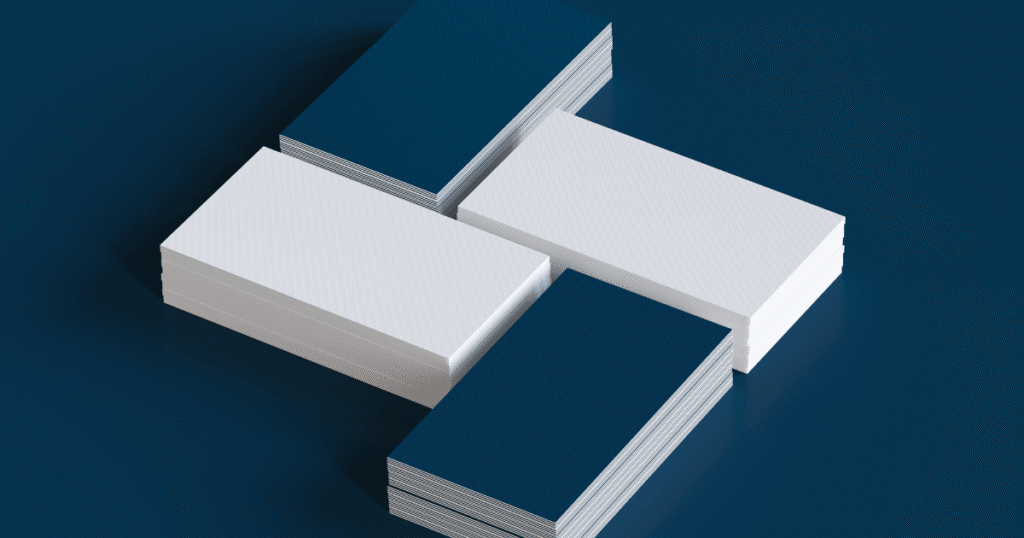The Power of a Well-Crafted Business Card
In the bustling world of modern networking and professional engagements, a meticulously crafted business card stands as a potent tool, leaving an indelible mark. Often underestimated yet profoundly impactful, business cards transcend mere contact details; they encapsulate your brand essence, making that crucial first impression count.
As a design novice navigating the realm of creating a business card, understanding the artistry behind this pocket-sized introduction becomes pivotal. With strategic design elements, color psychology, and thoughtful layout, even beginners can curate captivating cards that speak volumes about professionalism, creativity, and attention to detail.
In this comprehensive guide, delve into the fundamentals of business card design tailored explicitly for design novices. From deciphering the core components that constitute an impactful card to unraveling basic design principles and user-friendly tools, this guide aims to empower beginners in crafting standout business cards that wield lasting influence in every handshake and networking opportunity.
Understanding the Essentials of Effective Business Cards
Purpose and Significance of Business Cards
Business cards are more than mere contact details; they embody a multifaceted role in professional interactions:
- First Impression: They serve as an initial representation of your brand identity, setting the tone for future connections.
- Networking Tool: Business cards facilitate seamless networking, aiding in exchanging information efficiently.
- Brand Ambassadorship: They act as miniature brand ambassadors, encapsulating your brand’s essence and values.
- Memorable Marketing: Business cards become tangible marketing tools, leaving a lasting imprint on recipients.
Elements of an Impactful Business Card
The effectiveness of a business card lies in its design elements that harmoniously converge:
- Typography: Choosing suitable fonts that reflect your brand’s personality and ensure readability.
- Color Palette: Employing colors strategically to evoke emotions and convey brand messages.
- Layout Design: Arranging elements thoughtfully for visual appeal and ease of information consumption.
- Information Hierarchy: Structuring details in a clear hierarchy, emphasizing key information while maintaining balance.
A well-crafted business card harmonizes these elements to create a cohesive and impactful representation of your brand, capturing attention and fostering meaningful connections in a glance.
Crafting Your Own Business Card
Design Principles for Novices
For novices venturing into business card design, understanding fundamental design principles lays the groundwork for impressive creations:
- Balance: Achieving visual equilibrium by distributing elements evenly across the card.
- Contrast: Employing contrast in typography, colors, and shapes to create emphasis and visual interest.
- Alignment: Ensuring elements are properly aligned to maintain a cohesive and organized layout.
Tools and Resources for Novice Designers
Empowering novices with accessible design tools and resources paves the way for remarkable creations:
- Design Software: Explore user-friendly tools like Canva, Adobe Spark, or Visme for intuitive design functionalities.
- Templates: Utilize ready-to-use business card templates available on various design platforms for a head start.
- Online Tutorials: Access tutorials and guides on design principles, color theory, and typography for skill enhancement.
- Design Communities: Engage with design forums or communities for advice, inspiration, and feedback on your creations.
Arming yourself with these design principles and leveraging user-friendly tools and resources can turn novice designers into adept creators, enabling the crafting of striking business cards that make an unforgettable impact.
Dos and Don’ts of Business Card Design
Dos for Design Novices
For design novices, adhering to certain best practices ensures the creation of impactful business cards:
- Color Choice: Opt for a cohesive color palette that reflects your brand’s identity while maintaining readability and visual appeal.
- Font Selection: Use legible fonts and limit the variety of fonts for clarity and consistency across the card.
- Content Presentation: Organize information logically, prioritizing essential details and ensuring sufficient white space for readability.
Common Mistakes to Avoid
Steering clear of common design mistakes is crucial to uphold professionalism in business card design:
- Cluttered Design: Avoid overcrowding the card with excessive information or design elements, which can hinder readability.
- Poor Readability: Steer clear of overly intricate fonts or color combinations that compromise readability.
- Low-Quality Printing: Ensure high-resolution graphics and quality printing for a polished final product.
- Ignoring Bleed and Margin: Neglecting proper margins and bleed areas can result in unintended cropping during printing.
By embracing the dos and steering clear of common pitfalls, novice designers can elevate their business card designs, ensuring they exude professionalism and leave a positive impression.
Printing and Presentation
Choosing the Right Printing Options
Selecting the appropriate printing techniques, paper types, and finishes significantly enhances the impact of business cards:
- Printing Techniques: Explore options like offset printing or digital printing based on quantity and quality requirements.
- Paper Choices: Consider various paper weights, textures, and finishes to convey the desired impression, from matte to glossy or textured papers.
- Finishes: Enhance cards with finishes like embossing, foiling, or spot UV for added visual appeal and tactile experience.
Presentation and Networking Etiquette
Effective card presentation and networking etiquette amplify the impact of exchanging business cards:
- Proper Exchange: Offer and receive cards with both hands, ensuring recipients can read the information easily.
- Follow-Up Communication: Use received cards as reference for follow-up emails or messages, indicating interest in future connections.
- Leveraging Cards: Use business cards as conversation starters or memory aids during networking events to reinforce connections made.
By understanding printing options and mastering proper card exchange etiquette, entrepreneurs ensure their business cards not only visually impress but also serve as effective networking tools, fostering meaningful professional relationships.
Summarizing the Importance of Business Cards
Business cards, often overlooked in the digital age, remain invaluable assets:
- First Impressions: They serve as the initial touchpoint, creating a lasting impression long after the handshake.
- Brand Representation: Business cards embody your brand’s identity, values, and professionalism.
- Networking Catalyst: They act as conversation starters, fostering connections in a digital world.
Encouraging Creativity for Memorable Business Cards
To novices venturing into design, the canvas of a business card presents an opportunity:
- Unleashing Creativity: Embrace creativity within the confines of a small canvas, showcasing brand uniqueness.
- Continuous Learning: Explore design principles, experiment with tools, and learn from mistakes for growth.
- Personal Touch: Infuse cards with personal flair while maintaining professionalism for a memorable touch.
Your business card narrates your story in a few inches of space, an amalgamation of design elements, creativity, and professionalism. As a novice designer, embracing the craft of business card design is a step towards leaving an indelible mark on the professional landscape.
What is the intended use of your business card?
Before designing a business card, it’s important to determine the intended use of the card. Is it meant to be a simple contact card, or is it meant to showcase your brand and services? Knowing the purpose of your business card will help you design it appropriately.
Who is your target audience?
Your target audience will also impact the design of your business card. Consider the age, gender, profession, and preferences of your target audience. This will help you choose the appropriate style, color scheme, and font for your business card. For example, if you’re targeting a younger demographic, you may want to use bright colors and a modern font. If you’re targeting a more professional audience, you may want to stick with a more traditional design.
IChoose a card shape and size
Standard business card dimensions
The standard size for a business card is 3.5 inches by 2 inches. This size is widely recognized and fits easily into most wallets and cardholders. It’s also the most cost-effective size to print.
Alternative shapes and sizes
If you want to stand out from the crowd, you may consider alternative shapes and sizes for your business card. Some popular options include square cards, mini cards, and folded cards. Keep in mind that non-standard sizes may be more expensive to produce and could be harder to store for recipients. Make sure to consider the practicality of your chosen size and shape before making a final decision.
Select a color scheme and fonts
Choose colors that align with your brand
Your business card should be consistent with your brand’s color scheme. Use colors that align with your logo and other marketing materials. If you’re not sure which colors to use, consider using a color wheel to help you choose complementary colors.
Select fonts that are easy to read
When it comes to fonts, simplicity is key. Choose one or two fonts that are easy to read and align with your brand’s personality. Avoid using too many different fonts or using overly decorative fonts that are difficult to read. Remember that your business card should be easy to read at a glance, so choose fonts that are clear and legible.
Create a layout
Decide what information to include
Your business card should include your name, job title, company name, phone number, email address, and website. You may also choose to include your social media handles or a tagline that summarizes your business.
Organize the information in a logical and visually appealing way
Once you’ve determined what information to include, it’s important to organize it in a way that is visually appealing and easy to read. Consider using a hierarchy of fonts and sizes to draw attention to the most important information. You may also want to use icons or graphics to help break up the text and make the card more visually interesting. Remember to leave some white space on the card to prevent it from feeling cluttered.
Incorporate your branding
- Add your logo and brand elements
Your business card should include your logo and any other brand elements that are consistent with your other marketing materials. This will help to reinforce your brand identity and make your business card more memorable.
2. Use consistent branding across all materials
It’s important to use consistent branding across all of your marketing materials, including your business card. This will help to establish a cohesive brand identity and make your business more recognizable to your target audience. Make sure to use the same colors, fonts, and logo across all materials to ensure consistency.
3. Add images or graphics
Choose relevant images or graphics
Images or graphics can help to make your business card more visually interesting and memorable. Choose images or graphics that are relevant to your brand or industry. For example, a photographer may choose to include a photo they’ve taken on their business card, while a graphic designer may choose to include a small graphic or icon that represents their work.
Make sure they are high-quality and appropriate
When selecting images or graphics to include on your business card, make sure that they are high-quality and appropriate. Use only images or graphics that you have the rights to use, and avoid using copyrighted images unless you have obtained permission. Additionally, make sure that the images or graphics are appropriate for your target audience and align with your brand’s personality.
Consider adding special finishes
- Glossy or matte finishes
Adding a glossy or matte finish to your business card can give it a professional and polished look. A glossy finish can make colors pop and give the card a shiny appearance, while a matte finish can make the card look more subtle and sophisticated.
2. Foil stamping or embossing
Foil stamping and embossing are two special finishes that can make your business card stand out. Foil stamping involves adding metallic foil to certain parts of the card, such as your logo or text. Embossing involves pressing a design or text into the card, creating a raised effect. These special finishes can add a luxurious and high-end feel to your business card, but they can also make it more expensive to produce.
Proofread and finalize design
A. Check for typos and errors
Before finalizing your business card design, it’s important to carefully proofread it for any typos or errors. This includes checking for spelling mistakes, grammatical errors, and incorrect contact information. Make sure to have someone else review your business card as well, as a fresh set of eyes may catch mistakes that you missed.
B. Make any necessary revisions
If you notice any mistakes or areas for improvement during the proofreading process, make the necessary revisions before finalizing your business card design. You may also want to gather feedback from others to see if there are any changes that would make your business card more effective. Once you’re satisfied with the design, save the file in a high-resolution format that is suitable for printing.
Print and distribute
A. Choose a printing company
When it comes to printing your business cards, you have several options. You can choose to print them yourself using a home printer, but this may result in lower quality cards. Alternatively, you can use a professional printing company that specializes in business cards. Look for a company that offers high-quality printing, a variety of paper options, and quick turnaround times.
B. Order a sufficient quantity and distribute to your target audience
Once you’ve printed your business cards, make sure to order a sufficient quantity for your needs. You don’t want to run out of cards when you need them the most. Determine how many cards you’ll need for networking events, client meetings, and other business needs. Finally, make sure to distribute your business cards to your target audience. This may include handing them out at events, leaving them at local businesses, or including them in thank-you notes to clients.





